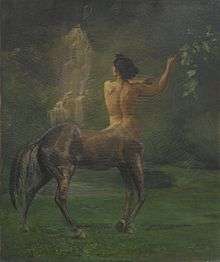Centaurides
| Grouping | Legendary creature |
|---|---|
| Sub grouping | Hybrid |
| Similar creatures |
Centaur Minotaur |
| Mythology | Greek mythology |
| Other name(s) | Kentaurides |
| Country | Greece |
| Habitat | Habitat of creature |

The Centaurides (Greek: Κένταυρίδες, Kentaurides) or centauresses are female centaurs. First encountered in Greek mythology as members of the tribe of the Centauroi, the Centaurides are only occasionally mentioned in written sources, but appear frequently in Greek art and Roman mosaics. The centauress who appears most frequently in literature is Hylonome, wife of the centaur Cyllarus.
Names
As a proper noun, Centauride or Kentauride refers specifically to a female of the tribe of the Centauroi or Kentauroi, commonly rendered in English as the common noun "centaurs"; as a common noun, centauride refers to any female centaur. Centauress is the more usual term in English, but centaurelle and centaurette may also occur.
Literary depictions

The rhetorician Philostratus the Elder gives a brief description of the Centaurides:
How beautiful the Centaurides are, even where they are horses; for some grow out of white mares, others are attached to chestnut mares, and the coats of others are dappled, but they glisten like those of horses that are well cared for. There is also a white female Centaur that grows out of a black mare, and the very opposition of the colours helps to produce the united beauty of the whole.[1]
In the Metamorphoses, Ovid gives a brief description of Hylonome:
In the high woods there was none comelier of all the centaur-girls, and she alone by love and love’s sweet words and winning ways held Cyllarus, yes, and the care she took to look her best (so far as that may be with limbs like that). She combed her glossy hair, and twined her curls in turn with rosemary or violets or roses, and sometimes she wore a pure white lily. Twice a day she bathed her face in the clear brook that fell from Pagasae’s high forest, twice she plunged her body in its flow, nor would she wear on her left side and shoulder any skin but what became her from best-chosen beasts.[2]
Shakespeare refers to centauresses in King Lear, Act IV, Scene vi, lines 124–125: "Down from the waist they're centaurs, / Though women all above".
Other appearances
In Walt Disney's film Fantasia, Beethoven's Pastoral Symphony is illustrated with scenes from Greek mythology, in which male and female centaurs, referred to by the studio as "centaurettes", feature prominently. The centaurettes appear in various situations, some of which depict them affecting the mannerisms of fashionable women in 1940. The centaurettes are shown in a variety of colours other than human skin tones, including blue, and were originally drawn bare-breasted, but applying the Hays code, the Motion Picture Producers and Distributors of America forced the animators to cover their breasts with garlands. Changing attitudes toward racial stereotypes in the 1960s led to the cutting of scenes depicting black centaurettes waiting on the others.[3]
See also
References
- ↑ Philostratus the Elder, Imagines, ii. 3.
- ↑ Publius Ovidius Naso, Metamorphoses.
- ↑ Pinsky, Mark I. (2004). The Gospel According to Disney: Faith, Trust, and Pixie Dust. Westminster John Knox Press. ISBN 978-0-664-23467-6.